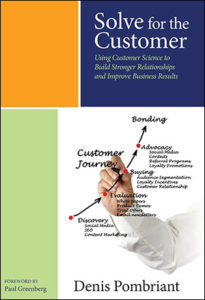
In our high-powered, win-at-all-costs business environment, the word “empathy” often evokes derision and scorn. Who has time to be a squishy, touchy-feely wimp overflowing with empathy? We’re all busy closing deals and kicking butt!
Kicking, closing, etc., is great and all — but empathy has genuine business value. Don’t forget that CRM has “relationship” right in the middle of it. Relationships are what keep customers, and keeping customers is the route to profitability. And you can’t create great customer relationships without a degree of empathy.
Go Through the Motions
For the lexicographically challenged or sociopathic among us, empathy is defined as “the psychological identification with or vicarious experiencing of the feelings, thoughts or attitudes of another.”
This is not something businesses are especially good at. We all tend to have our thinking bent toward the concerns of our businesses, for obvious reasons. However, as customers awaken to the growing power in their possession, we need to break out of our introspective mindsets and see ourselves — and our processes — as others see us (to mangle the words of the great Scottish CRM expert Robert Burns).
Even if you can’t muster a care for your customers, you should at least simulate empathy — there’s money in it, especially in the era of the subscription economy. You should apply it liberally to everything about your business, especially if you claim to be a “customer-centric company.”
Start at a basic level by understanding how your own processes impact customers. The way you do business probably was devised to maximize efficiency and profit, which makes sense. However, it may well be that what is good for you makes life harder for your customers.
For example, in a B2B sale, the customer wants to complete transactions in a timely, accurate way. If part of your process slows the customer down, it needs to be changed. It doesn’t matter if it’s making accounting or operations upset that they’re being forced to alter the way they work.
From your customers’ point of view, hiccups in your processes are speed bumps between them and satisfaction. If you’re unwilling to empathize with them, you’re saying that you’re willing to see them jump to a competitor.
See It Their Way
We’ve heard a lot lately about customer moments of truth (as in, Denis Pombriant’s recent book). Charting and then understanding them from the perspective of the customer is not just a useful exercise — it’s a critical way to focus on areas where empathy is most important.
What are those moments like for customers? Are you making them pleasant and reinforcing the relationship? Or are you making them challenging for your customers and then blaming those challenges on your process? That doesn’t work; your customers understand processes, but they believe processes are supposed to help them, not hinder them.
Customers have lots of ways to voice their frustrations these days. Seeing complaints or outright attacks on a public website or community can get your blood up and incline you toward snarkiness. Turn it around and understand where those complaints are coming from before you respond.
You should know something about that customer’s history (CRM, remember?) That will put those comments into context. From there you can help, apologize, offer additional support, or respond in some other way that is appropriate and that can help you save the relationship. Even if you can’t, it shows other customers and potential customers that you’re trying to think about the problems raised by the complaint from their point of view.
Before things get to that level, try to understand your internal business decisions with empathy in mind. It’s a good idea to have a procedure in place that considers the customer’s point of view regarding product, process and pricing decisions before they are executed. Designate someone on your team to play that role and to flesh out objections that might come up.
This approach can help you avoid decisions likely to cause customer dissatisfaction and lead to customer defections. It can help you modify those decisions to be more palatable to customers. Remember: Your customers should not be your bad-decision alert system, and they won’t have to be if you take the time to examine your plans from their perspective.
Find the Lesson
Sometimes, customers will leave. It’s just a fact of life. Don’t let your relationships end cold — stay engaged and try to learn from them. That will inform your view of other customers and help you understand what you should be doing to keep them from leaving.
You can’t do that unless you look at the reasons customers are leaving in their contexts. Customer defections often are very nuanced and are based on more things than just price. If you care enough to examine your losses from the perspective of the customers you’ve lost, you may reveal a weakness you can change to prevent future departures.
Perception is reality, the saying goes. Using empathy as a business tool is a way to understand customers’ perceptions — and thus, their reality when it comes to your business. Being empathetic isn’t being touchy-feely — it’s being smart.























































